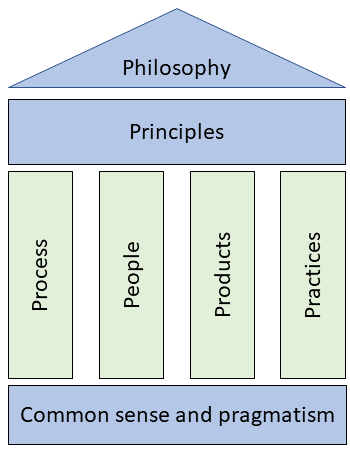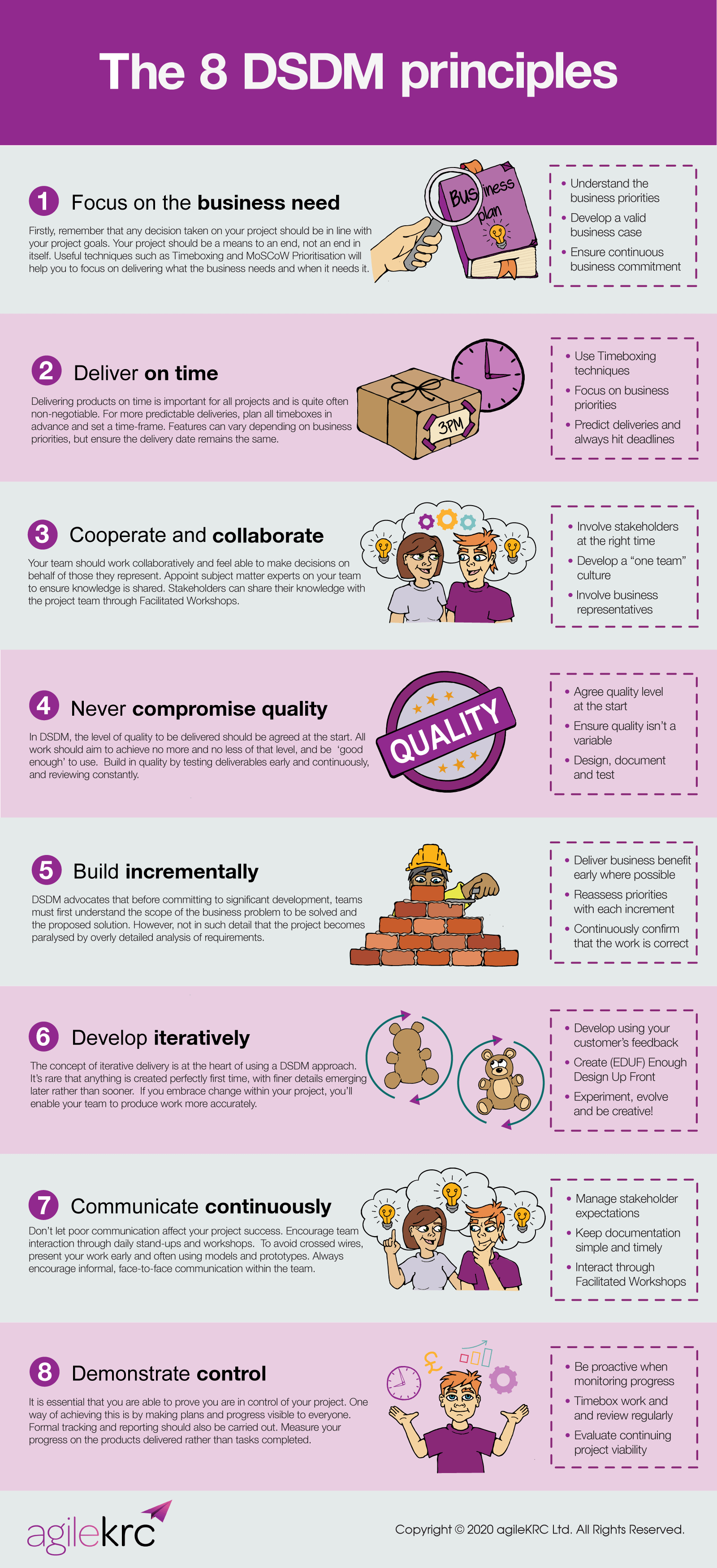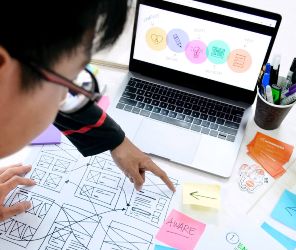
Origins
The Dynamic Systems Development Method (DSDM) is frequently seen as a lesser-known Agile marvel.
Inaugurated in 1995, DSDM has the longest history among Agile methods and is the sole method focusing on the management of Agile projects.
During the early 2000s, DSDM gained popularity among software developers who were searching for alternatives to rapid application development (RAD) techniques. One major drawback of RAD was its insufficient scalability for team collaboration. By fostering teamwork and scalability, DSDM became one of the first Agile methodologies adopted by the software development community.
DSDM played a part in the founding of the Agile Alliance and the Agile Manifesto in 2001. DSDM’s philosophy and principles had an impact on the development of the Manifesto for Agile Software Development, although DSDM broadens the scope of Agile beyond just software.
In summary, DSDM practiced Agile before it became a widely known term!
DSDM Atern
In 2007, a significant update was applied to the DSDM methodology, giving birth to DSDM Atern. The name ‘Atern’ came from the Arctic Tern, a bird renowned for its strong collaborative instincts and the ability to journey vast distances. This metaphor aptly captured the essence of the DSDM method’s rebranding.
In 2014, another revision to the method was required due to confusion over the term ‘Atern.’ The decision was made to revert to the original DSDM name, as it was a brand that everyone knew. Consequently, DSDM and DSDM Atern now carry the same meaning!
DSDM and the Agile Project Framework
During DSDM’s 2014 rebranding, the Agile Project Framework was incorporated. The DSDM Agile Project Framework has become the leading, validated agile approach that satisfies the dual demands of modern organizations: governance and rigor, coupled with agility and adaptability.
DSDM’s Agile Project Framework helps organizations tackle common project complications, such as late delivery, budget overruns, or the final deliverables being inadequate for their purpose.
DSDM’s Agile Project Management (AgilePM)
DSDM broke new ground by being the first agile framework to include agile project management capabilities. In contrast to Scrum, which is exclusively focused on product delivery during an iteration, DSDM also deals with project management aspects, making it unique among most other agile frameworks.
Thanks to DSDM’s ability to satisfy diverse agile demands, it was adopted as the foundation for the rapidly expanding AgilePM (Agile Project Management) qualifications, which are accredited by APMG International and the Agile Business Consortium.
DSDM – An Agile Solution
DSDM is a cyclical agile framework initially developed to execute software projects more effectively. Like other agile frameworks and methodologies, DSDM emerged as an alternative to the problematic waterfall processes that had become widespread in the software development industry during the late 20th century.
DSDM’s Expansion
DSDM is now expanding as agile methodologies have evolved. This expansion is attributed to organizations requiring more rigor and control when implementing agile in scenarios where the ‘ideal agile environment’ is lacking.
DSDM is an agile method that addresses the requirements of both simple product development projects with co-located teams and more complex projects involving multiple distributed teams working in various countries and time zones. DSDM can scale up to handle multiple teams working in dispersed environments, something that scaled agile frameworks have only recently started providing.
DSDM Overview
Not Just for IT
DSDM’s origins, like most agile frameworks and methods, can be traced back to the software development industry. However, in the past decade, agile has evolved and is no longer limited to IT.
DSDM can easily be applied to projects outside of software development. In fact, it can be used in any type of product development project. By delivering a usable product incrementally at the end of each timebox, DSDM can provide business value early in the product development lifecycle.
DSDM: Solo or Combined
The DSDM Agile Project Framework can be used either as a solo method or combined with other well-established project management methods such as PRINCE2, MSP, and PMI.
It is also an excellent wrapper for narrower Agile approaches like Scrum, ensuring that the entire project lifecycle is covered. DSDM also enables Scrum to be scaled up for use beyond just product development.
DSDM Elements

DSDM is an agile project framework composed of several parts:
- philosophy
- products
- people
- principles
- process
- practices
- pragmatism and common sense.
These parts together promote a philosophy of delivering business benefits as early as possible, ensuring the maximum return on investment (ROI) for an organization.
DSDM’s ‘realism and pragmatism’ might seem odd to some people, but this flexibility allows DSDM to avoid the rigidity that sometimes shadows other Agile approaches.
A fundamental premise of DSDM is that nothing is built flawlessly on the first attempt. As a general rule, 80% of a solution’s value can be delivered for 20% of the effort needed to create the full solution.
By prioritizing the business need, DSDM supports projects that strategically align with an organization’s change portfolio.
DSDM Principles
DSDM is based on 8 foundational principles that express its philosophy, culture, and work approach. These principles should be actively managed at all times, as any compromise on a principle can risk the successful execution and completion of a project.
DSDM aligns well with agile principles, prioritizing delivery, effective communication, collaboration, and continuous delivery. All DSDM principles assist in harmonizing DSDM practices with the agile philosophy.
Acquiring knowledge of DSDM’s guiding principles is imperative if you intend to enroll in an agile project management course such as AgilePM®, which is grounded in the DSDM method.
We will now look at the 8 DSDM principles.
1. Focus on the business need
- Understand business priorities.
- Create a valid business case.
- Enable continuous business commitment.
All decisions made within your project should correspond with the broader project goals. Projects must serve as a means to accomplish long-term business goals. Employing methods like MoSCoW and timeboxing assists in maintaining focus on delivering what businesses require, at the time they require it.
2. Deliver on time
- Use timeboxing.
- Focus on priorities.
- Predict deliveries.
Ensuring products are delivered on schedule is often imperative. For consistent deliveries, plan timeboxes ahead of time. While features may shift, delivery dates must persistently stay the same.
3. Cooperate and collaborate
- Promote stakeholder collaboration.
- Focus on team building.
- Work with business representatives.
It’s essential for teams to cooperate and make decisions on behalf of their represented parties. Involve subject matter experts in your team for seamless information sharing. Stakeholders can impart their knowledge and past experiences with project teams during regular workshop sessions.
4. Never compromise quality
- Set quality level at the start.
- Ensure quality doesn’t vary.
- Document and test.
Define the quality level to be delivered at the project’s commencement. Strive to attain this agreed-upon standard in all endeavors. Promptly test deliverables and persistently review them.
5. Build incrementally
- Deliver business benefit early.
- Reassess priorities with each iteration.
- Confirm that the work is correct.
As per DSDM, teams should first comprehend the range of the business issue they are addressing prior to starting development. Don’t allow the analysis of requirements to become so intricate that it paralyzes development.
6. Develop iteratively
- Use customer feedback.
- Create Enough Design Up Front (EDUP).
- Evolve and be creative.
Emphasizing iterative delivery is a hallmark of DSDM. Acknowledge that it’s atypical for something to be ideal right away and be ready to accept changes within your project to ensure success.
7. Communicate continuously
- Manage expectations.
- Keep documentation simple.
- Interact through workshops.
Boost team cooperation with routine stand-ups and workshops. Present your work often and early by using models and prototypes. Persistently promote casual, in-person communication within the team.
8. Demonstrate control
- Be proactive.
- Timebox work and review regularly.
- Evaluate project viability.
Improve project management by maintaining transparency in plans and progress for all team members. Adhere to formal documentation practices. Track progress based on products delivered rather than tasks accomplished.
Processes
DSDM combines iterative and incremental processes. The most pressing business requirements are addressed early on, while less essential ones are delivered at a later stage.
As an iterative framework, DSDM enables business representatives to review a continually evolving solution, provide feedback, and request changes during its development.
Phases
The DSDM process model contains 6 phases. Its distinct pre-project phase and post-project phase set it apart from the majority of Agile methodologies that solely focus on the delivery aspect.
People
DSDM includes participants from both business and development interests throughout the iterative and incremental development process.
Everyone involved in a project is given well-defined roles and responsibilities, working together within timeboxes to ensure the project stays on schedule.
Unlike other Agile methodologies, DSDM lays out the project manager’s tasks.
Practices
DSDM emphasizes 4 vital practices.
Timeboxing
DSDM, like various agile frameworks, organizes work within set time periods (timeboxes) resembling Scrum’s sprints. The goal is to deliver a usable product upon completing each iteration (timebox). Hence, DSDM follows both an incremental and iterative process for product development.
Facilitated workshops
Facilitated workshops assemble project stakeholders for cooperative efforts in defining business requirements and fostering shared comprehension.
Modelling and iterative development
Modelling helps team members visualize a business domain and refine their understanding of it. Modelling is employed to develop graphical representations of specific elements of the system or business area under development.
DSDM counts on a short feedback loop with the customer to deliver a functional software increment at the end of each iteration. It recommends the MoSCoW prioritization technique for selecting requirements for the team to address during a timebox. Requirements are typically documented as user stories.
DSDM also utilizes prototyping, concentrating on swift development, prompt feedback, and the early detection of issues. The fundamental DSDM philosophy highlights the importance of uncovering and resolving problems as soon as possible.
MoSCoW prioritization
MoSCoW prioritization supports businesses in categorizing requirements by determining Must have, Should have, Could have, and Won’t have requirements within each timebox.
Differentiating DSDM from Scrum
In the Agile community, it’s common for people to mistakenly consider Scrum as a project management methodology. Instead, Scrum is a development approach that fosters teamwork on both project and non-project activities to iteratively create products that deliver value to customers.
Scrum does not discuss the processes before a project (pre-project) or after a solution is implemented (post-project). The pre-project stage requires determining the project’s worth, while the post-project stage involves evaluating the benefits of the solution and deciding on any necessary improvements.
Conversely, DSDM addresses the pre-project and post-project phases and outlines the project manager’s roles. DSDM acts as an agile project management framework, while Scrum is a product delivery framework. Importantly, Scrum can be incorporated into DSDM projects during the other four project phases.
DSDM infographic
The following infographic shows the DSDM principles in greater detail.

Summary
The DSDM Agile Project Framework is an established and robust approach for agile project delivery, having been successfully employed in a wide variety of projects across the globe.
Currently, DSDM is the only agile project management framework in existence.
The framework continues to prove its competence in working effectively within and alongside existing corporate processes.
DSDM has been applied to both IT and non-IT projects since 1994, resulting in significant productivity increases, as independently validated by the UK Software Metrics Association.
For more information on how DSDM can aid your Agile project delivery, or for details about agile project management training, please contact us at agileKRC.
agileKRC has helped shape agile thinking by leading the teams that developed AgilePM® and PRINCE2 Agile®. We take a practical, success-oriented approach. We begin by taking the time to listen and understand your needs, before offering our real-world experience and expert guidance.













